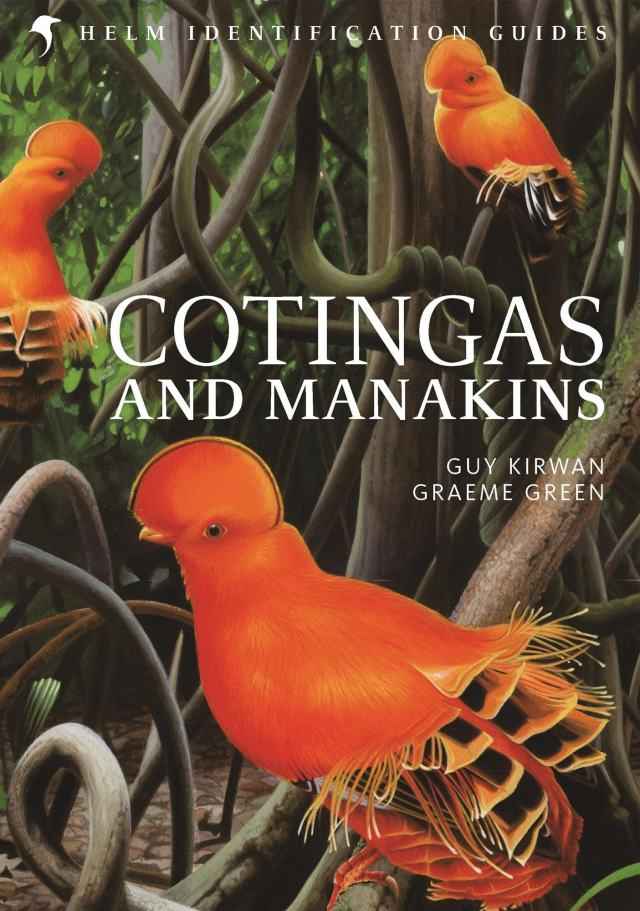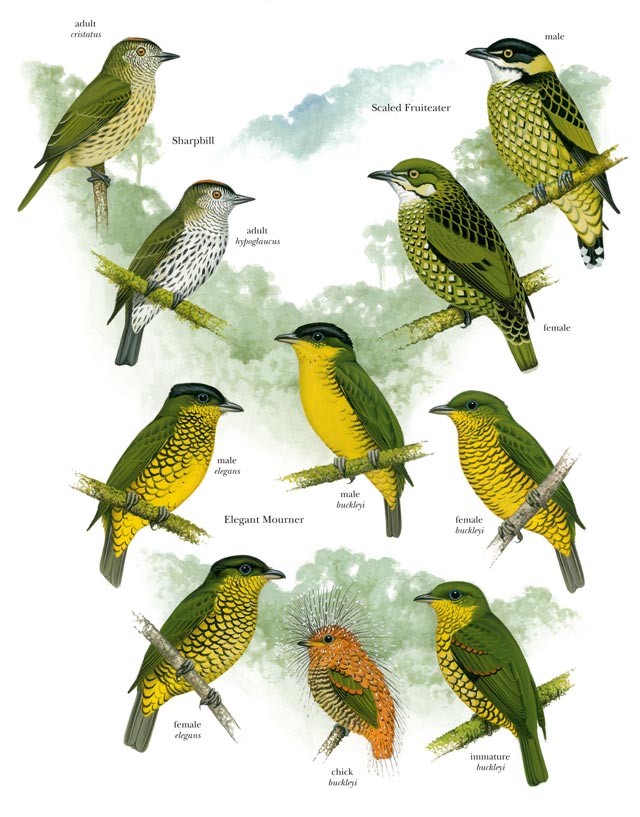Cotingas and Manakins by Guy Kirwan & Graeme Green

Cotingas and manakins are restricted to South and Central America, and are two of the most enigmatic and remarkable groups of birds. Many are exquisitely beautiful or have ornate plumage, some have amazing displays and bizarre breeding systems, and others give incredible vocalisations. Among the 130 species included within this broad grouping are some of the least known of all birds, as well as some of the best studied. Yet — until now — no-one has attempted to draw this information into a single volume.
Cotingas and Manakins follows the model of the other recently published family monographs in the Helm Identification Guides series, such as Reed and Bush Warblers. Apart from the species with 'cotinga' or 'manakin' in their English name, the book also covers the bellbirds, berryeaters, cocks-of-the-rock, fruitcrows, fruiteaters, mourners, piprites, plantcutters, purpletufts, schiffornises and umbrellabirds, as well as Broad-billed Sapayoa, Sharpbill and the near-mythical Kinglet Calyptura.
Introductory chapters cover movements and migration, voice, breeding biology, food and foraging, conservation and systematics. The introductory chapters are very well written and just it seems a pity that no photographs or illustrations have been included, since this would have helped to bring these pages to life and increased the chances of them being read. I was hoping to find a map showing the overall distribution of the species covered in the book, perhaps highlighting the overlaps and therefore the hotspots, but this was not to be.
The introductory chapters are followed by the colour plates — 34 in all, painted by Eustace Barnes. They are well executed but almost exclusively depict just adult birds. A few of the plates include a backdrop of the species' typical habitat, which, to my eye, adds to their attractiveness and provides useful context.
The species accounts are very detailed and cover identification, distribution, movements, habitat, description, measurements (including for different subspecies), geographical variation, voice, natural history, food and feeding, display, breeding and status. Each contains a clear distribution map showing the species' known range and, where appropriate, the approximate areas in which the subspecies occur. At the end of each species account is a selection of one or more high-quality photographs — there are about 400 photographs in the book as a whole. These are all taken in the wild, with the exception of the critically endangered Kinglet Calyptura (for which photographs of a museum specimen are shown). Overall, they represent a remarkable collection of images. A few, though, are reproduced at too small a size to do them full justice, or could have been cropped more tightly to show the birds and their salient features at a larger size. It would perhaps have been helpful to have included, even if at reduced size, at least one of Eustace Barnes' paintings at the start of each species account to avoid having to keep referring back to the plates, and to prevent possible confusion with the facing page, which in many cases includes the photographs of the preceding species.
I did notice that the index does not include alternative names. If, for example, you try to look up Shrike-like Cotinga, you will not find this species. You therefore either need to know its scientific name or its alternative English name. As it happens, Laniisoma elegans is now called Elegant Mourner — and the text on page 349 says "Previously known by the inappropriate but alluring name Shrike-like Cotinga." There may be very few such instances, but it would have helped the reader had such names been included in the index.

Sharpbill, Scaled Fruiteater and Elegant Mourner — taken from Cotingas and Manakins.
I must stress that these are minor quibbles and do not detract in any way from the value of this book, which is undoubtedly the most comprehensive work ever published on cotingas, manakins and their allies. It is a synthesis of all that is known about these birds from the literature (there are 34 pages of references alone) and from the authors' considerable personal experience, both in the field and from extensive museum studies. The book will therefore appeal as much to scientists as it will to world birders. It has been a long time in gestation and its production has undoubtedly involved a tremendous level of commitment on the part of all involved. Guy Kirwan and Graeme Green, and Eustace Barnes, should take great pride in what they have achieved — and are owed a great debt of gratitude for seeing it through.
Having spent a good few days poring over this book and, as I did so, reliving some of the encounters that I have been fortunate to experience with these fascinating birds, I now realise that I haven't seen enough. I have already started dreaming of my next trip to the neotropics! This is a monumental work that, in my view, is worthy of its £60 price tag. Buy it now — and start dreaming yourself...
Hardcover, 480 pages
Christopher Helm, RRP: £60.00
ISBN: 978-0-7136-6025-8


